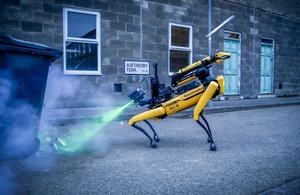

The UK Ministry of Defence scientists were working alongside L3Harris, Marlborough Communications Ltd and AeroVironment (Tomahawk Robotics).
Robotic dogs
The trials – investigating robotic Explosive Ordnance Disposal (EOD) capabilities – took place over four days. And they involved a number of scenarios.
For example, the robot was tasked to open and close doors autonomously and navigate stairs. The tests also included the remote classification and identification of possible threats, using sensors on the robots. Perhaps more significantly, the robot was then inspecting improvised explosive devices (IEDs) and firing disruptors to render them safe.
EOD
Also involved were drones with AI autonomous people detection capabilities. These were used to both help identify threats and monitor safety cordons. The idea is to help increase the pace of operations and reduce disruption to the public.
“By working with industry and combining cutting-edge robotics with existing expertise, we’re ensuring our bomb disposal teams have the best possible tools to carry out their vital work safely and effectively,” said the UK’s Minister for Defence Procurement and Industry, Maria Eagle.
“These advancements help the government deliver our Plan for Change and ensure defence is an engine for growth – protecting our national security while supporting rapidly evolving technologies.”
Bomb disposal operators gave positive feedback, says the Ministry, which will shape the next phase of Dstl investment in robotics for bomb disposal capabilities.
Image: UK government
See also: Dstl drone technology seeks to defuse threat of mined areas







